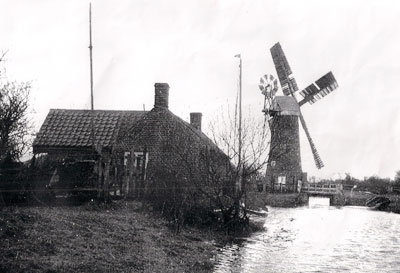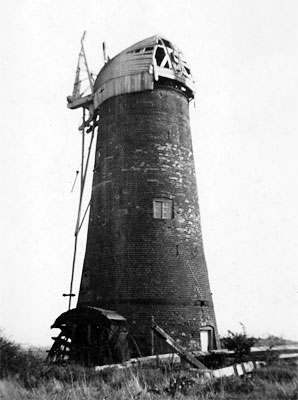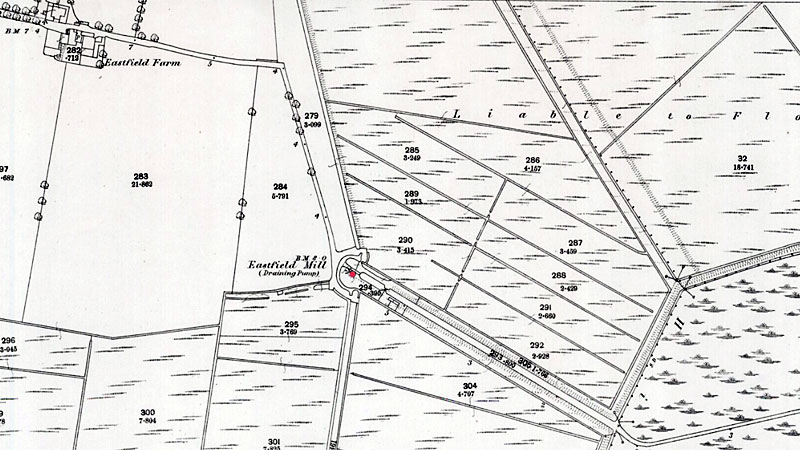
c.1912
Hickling Eastfield drainage pump |
 |
c.1912 |
The Gibbs family once ran Eastfield drainage mill and lived at the small mill house for generations. They also ran Hickling_Stubb_mill and Catfield_Swim_Coots mill. The mill had double shuttered sails, a tail pole and an 8 bladed fan by 1912. The Norfolk boat shaped cap had a petticoat.
|
Robert Gibbs (Edward Platten's maternal grandfather) married Mary Goose from Horsey. They had 22 children - twice. When one died - presumably the child in the tale below - they had another baby and so the family was once again with 22 children whose names were Robert, Abiathar, Mary Anne, Emily, Priscilla, George, William, Charles and others long forgotten. Sue Malleson - 9th October 2013 |
 |
1950 |
| A BROADLAND MILL |
| Now without sails, the mill is derelict. Its wooden top and brick tower stand out gaunt against a wide sky. On the horizon, across flat, desolate marshes, lie sand dunes bordering the North Sea. But once broad sails turned the mill scoop, which lifted water from a deep dyke into an outlet which carried it to Horsey Mere. From the beginning of the 19th century three consecutive generations of one family worked the mill in a lonely spot. The village street was two miles away along narrow, winding lanes. Their one-storey house was built on a bank, with the mill outlet at the back and a deep dyke in front. The home had only a living room and two bedrooms. However, about eighty years ago one millman had twenty-two children, though several died young. As the family grew the older children had to sleep on the upper floors of the mill some forty yards away, thought the shaft driving the scoop ran through them. One never-forgotten night, on a gale, when the children were in bed the sails and the top of the mill blew off. Luckily no-one was hurt. The first sails on the mill only just cleared the ground, and they had to be pulled round into the wind when it changed. Later a "flyer" fixed on an arm stretching from the mill top automatically kept the sails facing the wind. One summer day a six-year-old girl of the large family was sent to call father to dinner. He was digging early potatoes on a plot surrounding the mill. In her eagerness she forgot the turning sails one of which struck her head, and she died soon after. In consequence the mill tower was raised and then the sails, though menacing to anyone unaccustomed to them, were harmless. The nearest doctor lived fives miles from the mill. Illness was common especially in spring when the east wind blew. When they grew up some of the boys of the family went to sea, but in wintry spells at home they learned to shoot well. There was no lack of wild fowl. One cold afternoon two of the older sons were out shooting near Horsey Mere. They were sad because their favourite sister seventeen years old, was gravely ill at home. At dusk they saw a large white bird settle on some reeds. Going to put it up they saw nothing. On reaching home they were told that their sister had died about the time they had seen the mysterious bird alight. Is it surprising that they connected the two happenings! It is easy to be superstitious at dusk in the uncanny winter desolation of broadland. A hundred years ago Norfolk villages near the coast had an interest in smuggling. The mill and its neighbour at the end of Horsey Mere were said to have been used temporarily for hiding contraband landed on the lonely beach a mile or so away. The millman was allowed to keep a cow. From May onwards it fed on the "walls" - narrow banks parting marsh dykes. In winter it always stayed under cover and its small shed was never cleaned out till late spring. Fresh litter was daily spread over the old bedding. By the time of the new spring grass the cow stood nearly touching the roof, while a sloping ramp of manure spread far through the door. About fifty years ago the mill cow was the indirect cause of an unusual tragedy. It needed a vet on calving one early spring. He lived in a neighbouring village and made long journeys in a high gig pulled by a lively hackney. He reached the mill at dusk in very squally weather. The millman in his house about forty yards away had given up expecting the vet so late. To get to the house entailed opening a gate by the side of the mill intake and the vet stopped his gig by the side of it where there was a drop of nine feet to the water. Early next morning a man on his way to meet the millman was amazing to see a horse and gig in the dyke. Helpers who were fetched found the vet dead under the gig. It was supposed that when he was getting down to open the gate the horse, frightened by the whirling sails, backed the gig into the dyke. Perhaps the motorist does not realise that driving a horse and trap could be dangerous. However one farmer who some years ago took to motoring always maintained that he felt more secure behind the wheel than with reins in his hand. A turbine driven by electricity now drains the marshes around the mill and the house is falling into ruin. Thousands of summer visitors see the lofty tower as they sail on Horsey Mere and Heigham Sounds. How many give a passing thought to the lives of the many people who once lined and died in the shadow of a broadland mill. Edward W. Platten - 19?? |
 |
|
O. S. Map 1884 Courtesy of NLS map images |
O.S. map 1884: Eastfield Mill (Draining Pump) c.1912: Mill in working order with some shutters missing 1950: Mill lying derelict with no sails, fanstage with no fan and boards missing from cap c.1962: Mill blown up with dynamite by 'Rat' Moore of Goose Lane, Sutton on instructions from the Wort family |
If you have any memories, anecdotes or photos please let us know and we may be able to use them to update the site. By all means telephone 07836 675369 or
|
| Nat Grid Ref TG 43852340 | Copyright © Jonathan Neville 2010 |